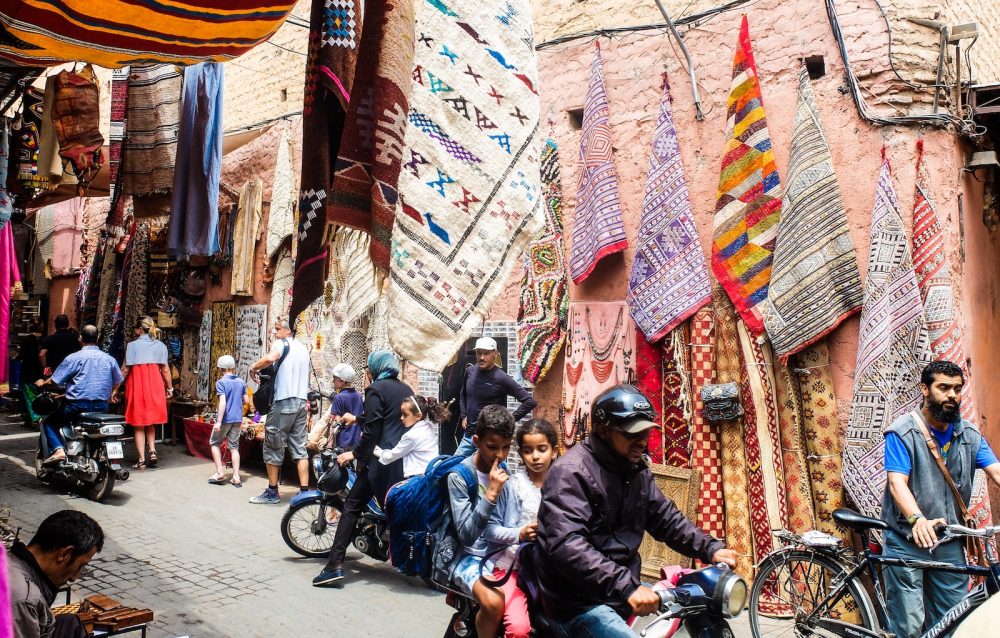I get out of the taxi about 50 yards from the ancient gate leading into the old city, called the medina in Arabic.
The afternoon is gloriously warm for early spring, and locals move about at an easy pace. A throng of uniformed schoolchildren pass by, lost in laughter and snacking on candied peanuts sold in a small shop on the corner.
I walk past a street vendor who has set his mobile kitchen against the outside walls of the medina. He’s frying rings of dough called sfenj, the Moroccan version of donuts. My mouth waters at the smell of fried batter laced in sugar.
Near the gate, distracted tourists mill about. Some hunt for artifacts to photograph. Others consult maps and work up the courage to go through the tall blue-tiled gate and lose themselves in the maze of the medina.
I stride past them with purpose, as one who calls this chaotic labyrinth my temporary home.
In 2019, more than one million tourists visited Fes.
Like its counterparts across North Africa, the walled medina of Fes is full of winding alleys, ornate palaces, mosaic-tiled fountains, and Islamic madrassas. It even has the world’s oldest university.
In 2019, more than one million tourists visited Fes, which is the country’s cultural and spiritual capital. Tourists come to marvel at the medina’s historical monuments and architectural treasures. In the city’s ancient souks, they shop for handcrafted rugs, ceramics, and leather goods.
But to the 200,000 Moroccans who live and work in the medina, tourists are largely irrelevant. Founded in the ninth century, the old city might seem like a living museum that has changed little over the centuries. But for locals, it’s simply home.
The walled medina of Fes is full of winding alleys, ornate palaces, mosaic-tiled fountains, and Islamic madrassas.
I step through the medieval gate and am hit by a familiar wave of sights, sounds, and smells. Passing a row of butcher stands, I avoid photobombing the tourists snapping pictures of the severed camel’s head propped on a well-worn chopping block.
The alley widens at a small intersection, and I step out of the way of a young man on a motorbike carefully maneuvering through the crowd. Food vendors are stationed along the larger path to the right, and I smell a mixture of freshly prepared foods: chickpeas roasting over hot coals, meat sizzling on skewers, and large, flat rounds of dense cornbread-like harsha baking on industrial-sized griddles.
The exterior walls of traditional homes rise above me like the cliffsides of an urban slot canyon.
I follow the narrow alley to the left as it descends further into the ancient medina. I hug the wall to make room for a man leading a donkey laden with propane cylinders. Anything that can’t be carried by hand through this car-free urban zone—bundles of blankets, carts of milk, furniture, construction materials—gets transported by donkeys like this one.
I approach a few shops selling trinkets, antiques, and souvenirs. The clumps of tourists thicken here as locals stream by and go about their daily activities.
I turn off the crowded alley onto a quiet, residential derb, a small side street. The exterior walls of traditional homes rise above me like the cliffsides of an urban slot canyon.
I hear footsteps following me up the derb, and a young Moroccan man calls out in French, “Ma’am, do you need a hotel? I can get you a good deal at an excellent guesthouse down the alley.”
The Idrissi women have drawn me into their lives and adopted me as one of their own.
I continue walking and call back to him in darija, the local dialect of Arabic, “No, brother, I’m not a tourist. I belong to Dar Idrissi—the Idrissi household.”
I’ve come to Fes to study Arabic for a few months. During this time, I’ve lived with the Idrissis, a family dominated by three near-adult sisters and their mother. The Idrissi women have drawn me into their lives and adopted me as one of their own. They affectionately call me tawila, which means the tall girl in Arabic.
I knock on the Idrissis’ door. A sister lets me in and pulls me into the small kitchen situated to the right of the entrance. She and her mother are preparing mint tea and meloui, a round pastry with layers of buttery dough, similar to a flattened croissant.
Their gossip fills the space with a mix of French and darija Arabic.
They call the other sisters into the kitchen, and we crowd around the small table for our afternoon tea. Their gossip fills the space with a mix of French and darija Arabic.
We’ve had sweet conversations around this rickety kitchen table. We’ve discussed hopes, aspirations, heartbreaks, and stories of Jesus. For now, I sip my tea in silence as the warmth of their chatter envelops me.
My time living with the Idrissis will soon end. I’ll move on and join my long-term team sharing the Gospel in another city in another country. But one thing won’t change: I’ll always have a seat at the Idrissi table in this ancient, thriving medina.
This account comes from a long-term worker. Names have been changed for security.
